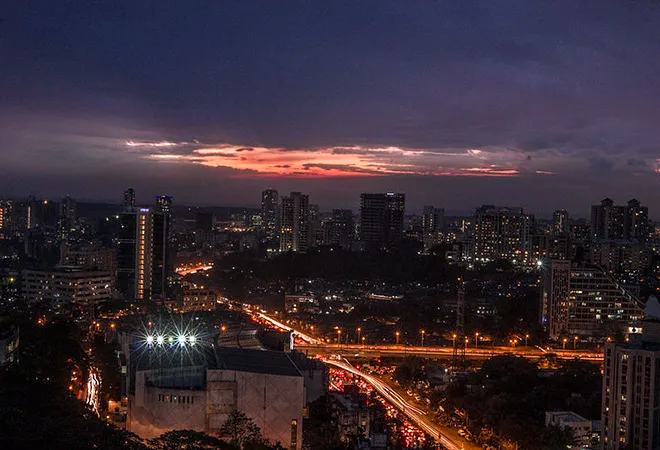-
CENTRES
Progammes & Centres
Location

Image Source: PranavBhasin/Wikimedia Commons
Mumbai skyline
As the world fast approaches the need to accommodate more than half of its inhabitants in urban areas, a new chapter on the era of the ‘Homo Urbanus’ is set to begin in the human history. From global financial power houses such as New York and London, the world’s fashion capital Paris to the tourist magnets like Singapore and Bangkok, cities of today are representative of economic prosperity and development.
The various dimensions to the evolution of cities, namely, the spatial organisation of an urban area, the growth rate of population, the pattern of residential and commercial real estate development, and the structure of infrastructural and transport networks are influenced by economic factors. That urban growth is driven by economic forces explains why the prime responsibility of cities is to fulfill aspirations of citizens by providing easily accessible economic opportunities and a decent quality of life.
An interaction between expansion of employment opportunities on the one hand, and upgraded infrastructure and increased provision of basic amenities on the other, is imperative for successful cities.
Yet, in India, urban renewal and development are seldom being coordinated with efforts of planned industrialisation. With this reality being the talking point, our discussion attempts to articulate the way forward.
Urbanisation of an area follows industrialisation and/or the growth of the services sector which, in turn, relies upon factors such as abundance of natural resources, geographical features, accessibility to inputs of production (e.g. skilled labour), supply of public utilities, favourable tax regime, balanced regulatory framework, the level of research and development activities etc.
For example, Mumbai’s urban journey to become India’s financial capital was anchored in its geographical characteristic of being a port. The British investment in the industrialisation of Bombay as a city of ports inaugurated the process of its urbanisation. So rapid has been this urbanisation that the city has earned the reputation of being the city of dreams. Mumbai has emerged as a major financial hub in response to the growing need for financial services associated with the trade and commerce of the city. Bengaluru’s urbanisation has accompanied its transformation into the Silicon Valley of India. One of the primary reasons that have underpinned this transformation is the abundant supply of skilled IT professionals produced by Bengaluru’s premier educational institutions.
It is also true that there are quite a few cities such as Mumbai and Bengaluru which have crossed their point of saturation and hence, the growth in employment, the expansion of infrastructure and transportation, and the increase in the supply of public amenities in such cities has not been keeping pace with the growing population. As a result, these cities are facing urban challenges like pollution, congestion, slum proliferation, squalor and lack of basic services.Many of these urban challenges are indicators of the extent of urban poverty.
Industrialisation has universally been the predominant force driving urbanisation. Unfortunately, industrialisation in India has failed to successfully take off even after 70 years of independence.
Consequently, urbanisation has not taken off for a large part of India, explaining why only 30 percent of India is urban according to the 2011 census. This has adversely affected employment generation, explaining why only 10 percent of Indians are employed in the formal sector. The entrants in the labour market are absorbed by the urban informal economy swelling the ranks of the urban poor to face various forms of deprivation. It must be emphasised that failed industrialisation rather than saturated cities is the bigger cause of urban poverty in India.
In its latest response to this failed industrialisation, economic policy and planning has envisioned the development of several industrial corridors across the nation. These include the Delhi-Mumbai Industrial Corridor (DMIC), Bengaluru – Mumbai Economic Corridor (BMEC), Chennai – Bengaluru Industrial Corridor (CBIC), Vizag - Chennai Industrial Corridor (VCIC) and Amritsar – Kolkata Industrial Corridor (AKIC). The Delhi Mumbai Industrial Corridor, which is work under progress, is being referred to as Make in India’s flagship Industrial Corridor.
These industrial corridors are expected to transform India into a global manufacturing and trading hub by creating urban agglomerations which are supported by high-speed and seamlessly connected transport and communication networks, and other such infrastructure facilities needed to lower logistics and inventory costs. Accordingly, each of these corridors will involve the construction of several industrial clusters, investment regions, knowledge and logistics hubs, modern ports and airports etc.
India’s Smart City Mission (SCM) is concerned with the transformation of Indian cities through urban planning based on technology and innovation, energy efficiency, environment friendliness, reliance on non-motorised and public transportation, increased citizen participation and so on.
The Mission promises adequate water supply, assured electricity supply, sanitation and affordable housing to those deprived. However, in doing so, it attempts to tackle the manifestations of urban poverty without uprooting the cause of such poverty. Unless the source of urban poverty is not dealt with, its manifestations like slum proliferation, deprivation, squalor, disease etc. will continue to surface.
The projects under the SCM seek to upgrade infrastructure and increase the provision of basic services. This will definitely improve livability of cities, productivity of its citizens and may also attract investment in small measure. The SCM does not give centre stage to economic concerns; rather any economic gain is only a by-product of this mission. The SCM is, after all, being executed under the aegis of the Ministry of Housing and Urban Affairs. There are hardly any linkages of this mission with the industrial corridor projects which are being handled by the Department of Industrial Policy and Promotion (DIPP), under the Ministry of Commerce and Industry. What is needed is a plan that strategises economic growth while galvanising urbanisation in a planned manner.
Learning from cities such as Mumbai and Bengaluru, such a plan should begin by determining the economic factors which can drive industrialisation and/ or growth of services sector in an area. This exercise should also gauge the possibilities of and identify challenges to augmenting such factors. Such an exercise should entail the formulation of a policy which aims at attracting investment, boosting industrial expansion and generating employment to combat urban poverty. Since the above mentioned tasks fall within the jurisdiction of the DIPP, their execution calls for collaboration between the Ministry of Housing and Urban Affairs, and the Ministry of Commerce and Industry.
Although planned urbanisation is one of the commitments of the industrial corridor projects, the implementation of the DMIC has failed to deliver on it; urbanisation being rendered as a by-product of this project.
The DMIC project is almost exclusively focusing on developing new greenfield projects and expanding existing industrial enclaves located outside the cities. The local government agencies of the existing cities which are included in the project influence area of the DMIC have hardly taken into account the impact of the DMIC in their plans. Evaluation of how opportunities and patterns of employment in the DMIC region will change due to this project provides information about issues such as rural-urban migration, possible changes in land value etc. which play an important role in urban planning. However, such an evaluation appears to have not been made. The DMIC project does talk about creating smart cities. However, the coverage of such plans is limited to the development of mere 24 such cities. The development of these cities has nothing to do with the SCM and is under the purview of the DIPP.
This discussion intends to point out the opportunity of and the need for collaboration between the SCM and the DMIC as well as other industrial corridor projects. As economic activity gains momentum in the DMIC region, new cities will begin to grow and the existing cities may also expand in order to accommodate the newly employed workforce and job seekers as well. Urban planning involving infrastructural needs and provision of basic services will have to respond to these changes which, if monitored and managed appropriately, will multiply the gains that accrue from planned industrialisation.
In conclusion, this discussion reiterates that the synergy between planned urban development and efforts of planned industrial growth has the ability to generate benefits far greater than would be achieved by these initiatives in isolation from each other. Hence, this discussion urges policymakers to recognise the value of this synergy and do the needful to realise the same.
The views expressed above belong to the author(s). ORF research and analyses now available on Telegram! Click here to access our curated content — blogs, longforms and interviews.

Renita DSouza is a PhD in Economics and was a Fellow at Observer Research Foundation Mumbai under the Inclusive Growth and SDGs programme. Her research ...
Read More +